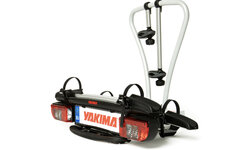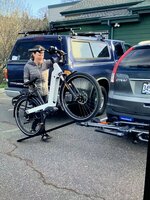Hi Dave, since the last comment I posted on using this rack for my Homage last year - I’ve found an even better rack than the Thule EasyFold XT you picture (it’s not marketed as Thule Velospace here in U.K.). The new rack I have is the Cykell, been around years, done in both 2 & 3 bike versions. Can also be found as the Whispbar Or more lately the Yakima Just Click 2/3. This rack is considerably lighter that the Thule, placing much less strain on the tow bar. I only ever carry two bikes, so I got shut of the Thule 3 bike carrier once I discovered the even better Cykell, the back rail is even higher than the Thule, meaning it can handle the Homage with ease. Another tip I picked up, buy some sheets of clear 3M sticky plastic film and cut to shape to stick to the seat stem, it saves all that wrapping with a rag business, great! The build quality is excellent, equal to Thule, the tilt and ball lock mechanism is superior to Thule I believe, what’s more in Europe they’ve been around years so are cheap used, got mine for £130 as new condition! Also has a ramp, which clicks in place on the rack for storage, built in wheels for moving around, was designed by cyclists for cyclists. The big problem with the Homage is the required height of the clamp arms on the carrier is nearly always much higher than most carrier designs, leaving you unable to get a good hold of the seat stem, the 3 bike Thule does the job, but the Cykell does it better.


